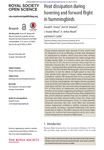Please use this identifier to cite or link to this item:
http://lib.hpu.edu.vn/handle/123456789/23589Full metadata record
| DC Field | Value | Language |
|---|---|---|
| dc.contributor.author | Powers, Donald R. | en_US |
| dc.date.accessioned | 2016-10-11T05:37:27Z | |
| dc.date.available | 2016-10-11T05:37:27Z | |
| dc.date.issued | 2015 | en_US |
| dc.identifier.other | HPU4160696 | en_US |
| dc.identifier.uri | https://lib.hpu.edu.vn/handle/123456789/23589 | en_US |
| dc.description.abstract | Flying animals generate large amounts of heat, which must be dissipated to avoid overheating. In birds, heat dissipation is complicated by feathers, which cover most body surfaces and retard heat loss. To understand how birds manage heat budgets during flight, it is critical to know how heat moves from the skin to the external environment. Hummingbirds are instructive because they fly at speeds from 0 to more than 12 m s −1, during which they transit from radiative to convective heat loss. We used infrared thermography and particle image velocimetry to test the effects of flight speed on heat loss from specific body regions in flying calliope hummingbirds (Selasphorus calliope). | en_US |
| dc.format.extent | 11 p. | en_US |
| dc.format.mimetype | application/pdf | en_US |
| dc.language.iso | en | en_US |
| dc.subject | Biology | en_US |
| dc.subject | Physiology | en_US |
| dc.subject | Biomechanics | en_US |
| dc.subject | Heat dissipation | en_US |
| dc.subject | Heat balance | en_US |
| dc.subject | Flight | en_US |
| dc.subject | Plumage | en_US |
| dc.subject | Hummingbirds | en_US |
| dc.title | Heat dissipation during hovering and forward flight in hummingbirds | en_US |
| dc.type | Article | en_US |
| dc.size | 967KB | en_US |
| dc.department | Education | en_US |
| Appears in Collections: | Education | |
Files in This Item:
| File | Description | Size | Format | |
|---|---|---|---|---|
| 0579_Heatdissipation.pdf Restricted Access | 967.55 kB | Adobe PDF |  View/Open Request a copy |
Items in DSpace are protected by copyright, with all rights reserved, unless otherwise indicated.
